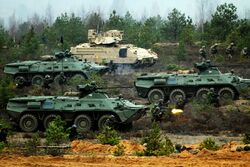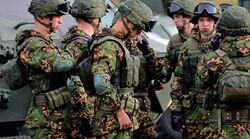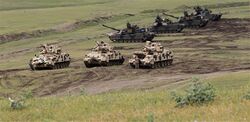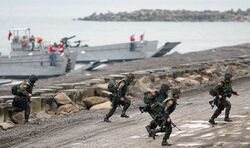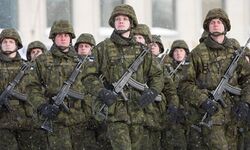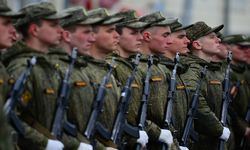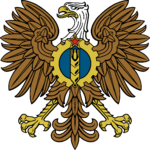Military of Florencia
| Union Defense Forces | |
|---|---|
 Banner of the UDF | |
| Motto | "In Defense of the Motherland" |
| Founded | 1866 |
| Current form | 1920 |
| Service branches |
|
| Headquarters | The Citadel, Saint Vera, Florencia |
| Leadership | |
| Supreme Commander in Chief of the UDF | Chancellor Maxim K. Tyrol |
| Secretary of the War Department | Chessa Impala |
| Personnel | |
| Military age | 17 |
| Conscription | 6 months minimum; varies by job |
| Available for military service | 12 million, age 17-50 (2019) |
| Reaching military age annually | 2 million (2019) |
| Active personnel | 1.2 million active personnel |
| Reserve personnel | 2.2 million organized reserves 7 million unorganized reserves |
| Expenditure | |
| Budget | $249 billion |
| Percent of GDP | 3.5% |
| Industry | |
| Domestic suppliers | Florencia |
| Foreign suppliers | Zhenia |
The Florencian military is at the forefront of the world's armed forces, it is a well oiled, well motivated machine fueled by an extensive military-industrial complex. The Chancellor is the Supreme Commander-in-Chief of the Union Defense Forces (UDF), National Militia (NM), and Scarlet Guards (SG). Together they are among some of the best equipped and well motivated armies in the world.
Military spending is a major aspect of the Union budget, typically around 10% of the GDP is committed to the military. This large budget and a well dedicated arms industry contributes to a cutting edge air force, expanding navy, and robust land force equipped with the most modern small arms, armored vehicles, aviation assets, and naval vessels.
Command and Organization
National Defense Committee and the Stavka
The Department of War (DoW) is an executive office within the cabinet charged with coordinating and supervising all agencies and functions of the Union concerned directly with national security and the military. Nominal administration of the military establishment is exercised by a civilian advisory board, the National Defense Committee—which includes the chief commissioner of the Commission for Security and Order (ComSec), director of the Office of Strategic Services, directors of nationalized war industries, in addition to representatives and senators from the All-Union Congress with invested expertise in national defense. The Secretary of the War Department is the principle assistant to the Executive Council on all matters relating to the defense of the nation.
Operational authority of the War Department is invested with the Stavka High Command of the Military, the senior uniformed general staff of the armed forces. The chairman of the Stavka is the highest ranking and most senior officer within the Union military and operational commander-in-chief of the Union Defense Forces, National Militia, and the Scarlet Guards. The Chairman's authority of the military is second only to the Chancellor and All-Union Congress.
A popular misnomer in the Florencian public and military itself is colloquially referring to both the Stavka High Command and National Defense Committee collectively as the Stavka.
Structure
The National Defense Act of 1920 established the military system in its present form. Disparate imperial army regiments and revolutionary volunteer militias loyal to the provisional government where synthesized into a new military representing the goals of the revolution. The result was a tripartite system of All-Union, constituent republic, and mass militarized organizations—the Union Defense Forces, National Militia, and Scarlet Guards. These forces are further supplemented by border troops administered by the Department of Justice and internal troops under the Commission of Security and Order.
The military would have been rebuilt from the ground up with the ideology of the 1919 revolution imprinted into the fiber of a traditionally conservative and bourgeoisie orientated organization. Three values in particular would be paramount in the transformation of the Florencian military; an armed populace, universal conscription, and military democracy.
Imperial tyranny had sought to disarm an entire population so as to gain complete autocratic control, an armed nation thus has the right and responsibility to be a bulwark against reactionary oppression, both foreign and domestic. The right to bear arms in the Florencian Union is considered sacrosanct. Reservist militiamen are permitted to safely store appropriate ammunition and service weapons in their private homes, subject to a military audit of course.
The notion of an armed nation goes hand in hand with the universal conscription practiced by the UFR. Every able bodied citizen that has turned 19 or graduated high school is expected to perform a year of service in the Standing Scarlet Guards. The constituent republic organized National Militia, the professional Union Defense Forces, federal managed reserves, and law enforcement agencies recruit volunteers who have graduated from the standing guards. Should a graduate not pursue a vocation in national security, they would be rolled in the Unorganized Scarlet Guards and be free to pursue their life as a civilian, subject to yearly refresher courses or training exercises. Should a citizen be a conscious objector or be unfit for national service would perform alternate, charity, or auxiliary work for a full year.
The ideology of democracy was a leading factor for the revolution and like how such values revolutionized Florencian civil society, so did democracy transform the military. The UFS is unique in it's commitment to military democracy: soldiers's councils, elections of NCO's, and a less rigid code of military discipline characterize this democratic process.
Military Democracy
The success of the 1919 Revolution would lead to a drastic change in the how the form of the Florencian military would take shape. The bulk of revolutionary fighting forces subscribed to the principles of social republicanism that the Provisional Government were quick to decree in the constitution. As such, defected imperial regiments, revolting naval detachments, workers' shock battalions, and rural peasantry militia had organized their own soldiers' councils. Furthermore quite a few units elected their own non-commissioned officers. It wasn't unheard of several revolutionary naval ships electing their own beloved captains.
The committee tasked by the provisional government to reform and retool the newly constituted Union Defense Forces for the protection of the nascent Florencian Republics was thus dealt a difficult task. Respect for the spontaneous expressions of solidarity amidst the military and the principles of the revolution was paramount. Yet order, discipline, standardization, and a proper experienced chain of command are the necessary foundations of any effective fighting force.
Ultimately after much trial and tribulation the present shape of military democracy took form within the professional Union Defense Forces, reservist National Militia, and even the conscript training apparatus of the Scarlet Guards. A soldiers' council exists in every military detachment. Organized and coordinated by the company, battalion, and so forth. The naming convention of a council differs between branches or services. For instance, in the Republican Navy it is a sailors' council, for the airborne forces a Paratrooper Council. A set number of delegates are elected to these councils to represent their comrades to the chain of command.
In regards to non-commissioned officers, the practice of soldiers electing all sergeants and so forth was put to a stop in 1920. However the highest ranking enlisted soldier at the platoon, company, and battalion level is elected to the position by their unit. A set number of candidates are picked by the detachment commander and then elected to the post. In this way they are not only the second in command to the commander, but an advocate for the enlisted.
The existence of the soldiers' councils and elections of senior non-commissioned officers is protected by the Uniform Code of Military Justice, which is the foundation of law within the Union Defense Forces. The Union of Florencian Republics is unique in that it is the sole practitioner of military democracy in the world.
Branches
The Union Defense Forces (UDF) is the professional standing military of the Florencian Republics and consists of two branches and four independent armed services: the Union Army, Republican Navy, Union Strategic Weapons Command, the Air Defense Forces of the Republics, the All-Union Marine Corps, and the Union Stellar Forces Command. A byproduct of revolutionary values and federalism places the structure of the active professional armed forces separate of the massed reservist levy force in the form of the Scarlet Guards. However given the sole focus of the Scarlet Guards as a ground training contingent, both the Union Air Defense Forces and Republican Navy organize reservist command formations with a pool of former airmen and sailors.
Union Army (UA)
The Union Army is the oldest, largest, and most diversified branch within the Union Defense Forces. It traces it's lineage to defected Imperial Army units and rural citizen militias of 1919. In many ways the Union Army is a microcosm of the rest of the Defense Forces, with their own rocketry troops, air defense troops, aircraft, and paratroopers. Originally a loose grouping of patriotic rebels resisting tyranny, the army has grown exponentially in terms of size and power. The mission of the Army is the defense of the Florenian people and territory on the land and air. To fulfill this mission the army maintains extensive commands, deploys a wide range of weapons and vehicles, and makes a great use of special purpose troops.
The Union Army does not administer a reservist formation directly subordinate to All-Union command. The separate conscript training organization that is Scarlet Guards in addition to the professional reservist National Militia fill this void. For all intents and purposes the Scarlet Guards and constituent republican ran National Militias are de facto organized as the reservist formation of the Union Army. Replacements from the guards would replenish regular army units during wartime, national militia units operate alongside their active counterparts, and all forces ultimately fall under operational authority to the Stavka.
For administrative purposes the Union Army is divided into the Army Ground Forces (training and procurement of combat troops and equipment), Army Rear Forces (rear support services that provide the material, infrastructure, and other miscellaneous services), Union Army Air Forces (frontal aviation, strategic bombers, mobile anti-air defense troops) and the Air Descent Troops (mechanized paratrooper and air deployable guerrilla units).
Independent Arms of Service
Union Strategic Weapons Command (USWC)
Air Defense Forces of the Republics (ADF-R)
The Air Defense Forces took to its redefined mission after the dissolution of the independent air force branch with great vigor and dedicated its assets to the job of fighter, bomber, and missile interception. The branch comprises three specialized types of troops to provide for the anti-air defense of Union territory. That being the Radio-technical troops, Anti-Air Defense troops, and Fighter Aviation (FA). The principle role of Air Defense Forces is the interception of enemy bomber forces should they penetrate Union airspace, or intercontinental ballistic missiles on a trajectory for Florencian cities. The Air Defense Corps deploys heavy interceptors, extensively organized SAM sites, and an encompassing expansive radar array for the defense of Union air space.
All-Union Marine Corps (AUMC)
The expeditionary wing of the Defense Forces. The Florencian marines are built around flexible combined arms formations that enable them to conduct seaborne landings and seize hostile territory from sea. By utilizing the sea-lift capability of the Navy the Marine Service is able to operate far from Union shores and respond to emergencies quicker than their Army counterparts. Also charged with both the defense of the Navy vessels and installations on land and sea. Perhaps most known for their unique "esprit de corps", ferociousness in combat, and vulgarity.
Union Stellar Forces Command (USFC)
The National Militia
The Scarlet Guards
The Scarlet Guards were formed as an integral part of the Florencian Total National Defense doctrine. During times of peace the Scarlet Guards act as training force where draftees fulfill their obligation of national service. Conscription in Florencia has existed since the Imperial period. The system of conscription used by the Empire was typically inefficient and prone to abuse, not to mention countless draftees were forced into lengthy contracts. With the victory of the forces of revolution following 1919, the new military of the Florencian Republics was to be built up to reflect the new change in governance and society.
A fully professional armed forces was sought by the All-Union Congress, however conscription was deemed by the government to still be deemed a necessary force to ensure the security and safety of the revolutionary regime. The decision for this was two-fold. Following the successes of the Revolution, the new Florencian Republics were still in ruin. The economy was shattered, cities lay in rubble, crops were wilted. Millions of Florencians were unemployed. Separatist elements and forces were gathering support in the fringe areas of the Union. The newly created Union Army could not aid in the rebuilding of the nation and combat counter-revolutionary dangers at the same time.
The Scarlet Guards were thus created by the Executive Council with the expressed consent of the congress. This new armed organization draws it's lineage from the radicalized Workers' and Peasents' Scarlet Brigades formed under the Social Republican League during the revolution. It is an entirely separate entity from the Union Defense Forces, but still subordinate to the Department of War and thus the Stavka. The Scarlet Guards are organized into two different components; the Standing Scarlet Guards and Unorganized Scarlet Guards.
Standing Scarlet Guards
The Standing Scarlet Guards are organized into regional training brigades where able bodied Florencians of both genders fulfill their service commitment to the state. Draftees in the Scarlet Guard are thus seventeen, eighteen, or nineteen years of age and fresh out of secondary school or slightly older and just now in service to the state after receiving a waver for higher education. Recruits into the guard realize a contract of either six, nine, or twelve months to the state. Service length varies considering the amount of technical training needed in what job a draftee pursues.
During their term of service a recruit undergoes basic combat training, basic individual job training, partakes in training exercises, and can be embedded with the Union Army for technical job experience. A draftee is expected to become a competent riflemen by the completion of their training and understand the basics of their occupational specialty.
The secondary peacetime role of the guard is to act as a work corps and community outreach program. After completing their basic training portion, a Scarlet Guardsmen can expect to find themselves in the outdoors for weeks at a time during a field training exercise, and then return to civilization to partake in road construction or working within an elderly town home. The conservation and development of Florencia's natural resources along with social work in educational, agricultural, and community programs is paramount to the mission of the guards. In addition Scarlet Guard training brigades are expected to and prepared to aid the federal and constituent republican governments in disaster relief response. This sort of work would typically be coordinated with a republic's National Militia component. Every year over a million draftees pass through the Standing Scarlet Guards before returning to civilian life as a reservist, or pursuing a professional career in the military or policing.
Unorganized Scarlet Guards
Between 3 and 7 million Florencians between the ages of 17 and 45 could theoretically be called up to fight under Scarlet Guard command. Those recruits who have finished their training and service and choose not to pursue a vocation in the professional defense forces are enrolled in the inactive Unorganized Scarlet Guards. For all intents they are now civilians, though they are subject to yearly training call ups or exercises. One a reservist reaches the age of 35 they are no longer required to partake in annual training. The Unorganized Scarlet Guards exist to provide the framework for the mass mobilization of the country in the event of war. Doctrine would require new Union Army divisions to be mustered and these reservists would form the mass of new soldiers, or provide reinforcement to pre-existing army formations.
Office of Strategic Services to the Stavka
The OSS is directly an independent uniformed intelligence gathering and covert espionage apparatus subordinated directly to the Stavka High Command. Despite being apart of the military establishment the service essentially acts as the virtual foreign intelligence service for the whole of the Union government. Uniformed members of the OSS range from deep cover special agents to militarized special purpose operations teams. Responsibilities include more wartime orientated duties such as sabotage, subversion, use of propaganda and any other actives under the umbrella of espionage. Most recently this has included the training of foreign paramilitaries. More wartime orientated activities include the covert surveillance of enemy forces during wartime or commando like operations conducted by OSS special purpose troops. The OSS maintains an extensive amount of spetsnaz reconnaissance groups that largely perform similar roles to their army counterparts. However Union Army Diversionary Troops are primarily concerned with wrecking havoc behind enemy lines, whereas OSS Spetsnaz is more so focused on gathering intelligence and eliminating high valued targets.
In practice with Florencian maskirovka ideology, very little is publicized about the Office of Strategic Services. The size and general scope of the military intelligence collecting branch is kept vague and secretive for a reason. It is speculated that there are OSS operatives serving in nearly every corner of the globe. It can also be reasonably theorized that OSS penetration of foreign nations is so extensive that hidden caches of weapons lie in wait, ready to be used by spetsnaz or foreign guerrillas. The extent and validity of such hearsay is difficult to discern.
Combined Special Operations Center — 450th OSS Special Purpose Group — Union Army: 1st Special Combat Applications Regiment (1st-SCAR/Jessie Scouts) "Saturn Group" — Union Navy: 42nd Naval Special Reconnaissance Detachment "Cascade Group"
The most elite tier one group of operators in the Union belong to the Office of Strategic Service's own spetsnaz Saturn and Cascade. Both groups are the premier special forces of the Union and specialize in hostage rescue, special reconnaissance, direct action, and assassination. While both groups perform the same missions and have the same operational capabilities, the culture of both groups are completely different. Saturn Group recruits exclusively from the army's diversionary troops, whose operators are already veterans of conflict and have several years of experience under their belt. Cascade Group is comprised of a mixture of OSS and navy spetsnaz operators who are fresh out of training and the top of their class.

